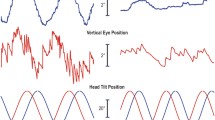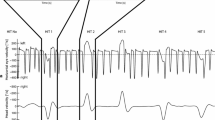Summary
Reorienting the head with respect to gravity during the postrotatory period alters the time course of postrotatory nystagmus (PRN), hastening its decline and thereby reducing the calculated vestibular time constant. One explanation for this phenomenon is that the head reorientation results in a corresponding reorientation of the axis of eye rotation with respect to head coordinates. This possibility was investigated in 10 human subjects whose eye movements were monitored with a three-dimensional magnetic field — search — coil technique using a variety of head reorientation paradigms in a randomized order during PRN following the termination of a 90°/s rotation about earth vertical. Average eye velocities were calculated over two time intervals: from 1 s to 2 s and from 7 s to 8 s after cessation of head rotation. The time constant was estimated as one third of the duration of PRN. For most conditions, a reorientation of the head with respect to gravity 2 s after the rotation had stopped did not significantly alter the direction of the eye velocity vector of PRN with respect to head coordinates. This strongly indicates that, in humans, PRN is mainly stabilized in head coordinates and not in space coordinates, even if the otolith input changes. This finding invalidates the notion that the shortening of PRN due to reorientation of the head could be due to a change of the eye velocity vector towards a direction (torsion), which is not detectable with the eye recording methods (electrooculography) used in earlier studies. The results regarding the vestibular time constant basically confirm earlier findings, showing a strong dependence on static head position, with the time constant being lowest if mainly the vertical canals are stimulated (60° nose up and 90° left ear down). In addition, the time constant was drastically shortened for tilts away from upright. The reduction in vestibular time constant with head reorientation cannot be explained solely on the basis of the dependence of the time constant on static head position. A clear example is provided by head reorientations back towards the upright position, which results in a decrease in the time constant, rather than an increase that would be expected on the basis of static head position.
Similar content being viewed by others
References
Baloh RB, Richman L, Yee RD, Honrubia V (1983) The dynamics of vertical eye movements in normal human subjects. Aviat Space Environ Med 54:32–38
Benson AJ, Bodin MA (1966a) Interaction of linear and angular accelerations on vestibular receptors in man. Aerosp Med 37:144–157
Benson AJ, Bodin MA (1966b) Comparison of the effect of the direction of gravitational acceleration on postrotational responses in yaw, pitch and roll. Aerosp Med 37:889–897
Collewijn H, Van der Steen J, Ferman L, Jansen TC (1985) Human ocular counter roll: assessment of static and dynamic properties from electromagnetic scleral coil recordings. Exp Brain Res 59:185–196
Crawford JD, Vilis T (1991) Axes of eye rotation and Listing's law during rotations of the head. J Neurophysiol 65:407–423
Ferman L, Collewijn H, Hansen TC, Van den Berg AV (1987) Human gaze stability in the horizontal, vertical and torsional direction during voluntary head movements, evaluated with a three-dimensional scleral induction coil technique. Vision Res 27:811–828
Fernandez C, Goldberg JM (1971) Physiology of peripheral neurons innervating semicircular canals of the squirrel monkey. II. Response to sinusoidal stimulation and dynamics of peripheral vestibular system. J Neurophysiol 34:661–675
Fetter M, Hain TC, Zee DS (1986) Influence of eye and head position on the vestibulo-ocular reflex. Exp Brain Res 64:208–216
Guedry FE (1965) Orientation of the rotation-axis relative to gravity, its influence on nystagmus and the sensation of rotation. Acta Otolaryngol 60:30–49
Hain TC (1986) A model of the nystagmus induced by off vertical axis rotation. Biol Cybern 54:337–350
Hain TC, Buettner UW (1990) Static roll and the vestibulo-ocular reflex (VOR). Exp Brain Res 82:463–471
Merfeld DM, Young LR (1992) Three-dimensional eye velocity measurements following postrotational tilt in monkey. In: Cohen B, Tomko DL, Guedry F (eds) Sensing and controlling motion. Vestibular and sensori motor function. Annals of the NY Acad Sci 656:783–794
Minor LB, Goldberg JM (1990) Influence of static head position on the horizontal nystagmus evoked by caloric, rotational and optokinetic stimulation in the squirrel monkey. Exp Brain Res 82:1–13
Raphan T, Cohen B (1988) Organizational principles of velocity storage in three dimensions: the effect of gravity on cross-coupling of optokinetic after-nystagmus. Ann NY Acad Sci 545:74–92
Raphan T, Cohen B, Kenn V (1981) Effects of gravity on rotatory nystagmus in monkeys. Ann NY Acad Sci 374:44–45
Raphan T, Matsuo V, Cohen B (1979) Velocity storage in the vestibulo-ocular reflex arc (VOR). Exp Brain Res 35:229–238
Robinson DA (1963) A method of measuring eye movement using a scleral search coil in a magnetic field. IEEE Transactions on Biomedical Electronics, BME 10:137–145
Schrader V, Koenig E, Dichgans J (1985a) The effect of lateral head tilt on horizontal post rotatory nystagmus I and II and the Purkinje effect. Acta Otolaryngol 100:98–105
Schrader V, Koenig E, Dichgans J (1985b) Direction and angle of active head tilts influencing the Purkinje effect and the inhibition of postrotatory nystagmus I and II. Acta Otolaryngol 100:337–343
Tweed D, Cadera W, Vilis T (1990) Computing three-dimensional eye position quaternions and eye velocity from search coil signals. Vis Res 30:97–110
Van der Steen J, Collewijn H (1984) Ocular stability in the horizontal, frontal and sagittal planes in the rabbit. Exp Brain Res 56:263–274
Viéville T, Masse D (1987) Ocular counter-rolling during active head tilting in humans. Acta Otolaryngol 103:280–290
Author information
Authors and Affiliations
Rights and permissions
About this article
Cite this article
Fetter, M., Tweed, D., Hermann, W. et al. The influence of head position and head reorientation on the axis of eye rotation and the vestibular time constant during postrotatory nystagmus. Exp Brain Res 91, 121–128 (1992). https://doi.org/10.1007/BF00230020
Received:
Accepted:
Issue Date:
DOI: https://doi.org/10.1007/BF00230020




